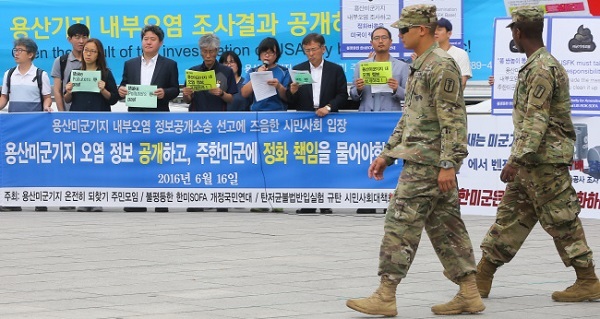A contaminant detected in ground water beneath a US Forces Korea garrison in central Seoul was 162 times higher than the permissible level, a government report revealed by civic groups showed Tuesday.
The garrison around Noksapyeong Station has been suspected as the main source of contaminants such as petroleum and benzene that have polluted the neighborhood of Yongsan for decades.
The revelation came after the Supreme Court ordered the South Korean government to disclose the results of a 2015 study on underground water contamination found within its proximity.
The Environment Ministry conducted several site inspections on possibly polluted 12,000 square meters of land and 7 million liters of underground water around the army base from May 2015, but declined to release the outcome to the public, citing possible diplomatic friction with the US.
 |
Civic groups demand the government release information about the level of pollution at the US military base in central Seoul at press conference held near the camp last June. (Yonhap) |
Lawyers for a Democratic Society, a group of activist attorneys, filed a petition with a local administrative court three months after the ministry’s announcement.
An internal investigation revealed the average concentration of benzene in the groundwater was 162 times over the safety limit of 0.015 milligrams per liter. Among 14 monitoring wells of 15 to 20 centimeters in diameter, four contained benzene levels higher than the standard, showed the report.
“We suspect the environment in the army base to be seriously polluted based on the US defense report acquired by a South Korean civic group,” said the Seoul Metropolitan Government. “We have strongly urged the Environment Ministry to take immediate measures on the matter.”
The report written by the US Department of Defense revealed there were at least 84 environmental issues associated with the military base. Along with the recovery of the base, the government has requested specific details and measures on all contaminations, a US-Korea bilateral meeting, and renegotiation of the Status of Forces Agreement.
The current agreement only emphasizes the US military’s legal responsibility for contamination within its camp, not adjoining areas.
Efforts to recover the area were launched by the city government in 2001 and a total of 5.1 billion won ($4.7 million) was invested in the project.
Seoul government plans to invest an additional 540 million won this year and widen the parameters of its environmental monitoring.
The Yongsan army base has been asked to remove all pollutants before its scheduled relocation to Pyeongtaek, Gyeonggi Province, by the end of 2018.
By Jung Min-kyung (
mkjung@heraldcorp.com)








